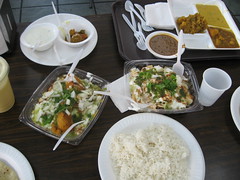|
|
FoodFrom The Peopling of New York City: Indian CommunitiesMany Indian immigrants remain emotionally connected to the food, clothing, and language they grew up with. Subsequently, stores that provide the means of keeping in up with traditional cuisine and dress have grown to be pinnacles of Indian Immigrant communities. As residents of New York City, total cultural preservation is not possible. Often, products that are unique to different regions of India can be found side by side on grocery store shelves, or listed next to each other on restaurant menus, as well as products that are wholly American or unique to other immigrant communities.
Food stores and shops are especially crucial to preserving the culture of Indian immigrants in New York City because they provide easy access to inexpensive products that aren't available at most American grocery chains. However, there are certain products such as chocolate syrup and sauces from other countries that find their way into these grocery stores, as can be seen at the end of the video below:
During a visit to Jackson Heights, members of our group browsed the produce section outside of Subzi Mandi on 37th street:
Northern Indian food, which is what Americans tend to think of when they think of "Indian Food," is heavier and milder than its Southern counterpart, which uses more coconut milk than yogurt and is potently spiced. This is primarily due to the fact that the cooler Northern Indian climate is more complimentary with heavy food, while the hot Southern Indian climate is an ideal environment for tropical vegetation (such as coconuts) and spicy food that ultimately has a cooling effect by causing perspiration. Other distinctions between the two regions are a result of cultural rather than climatic differences. According to an October 2008 article in the New York Times, Northern Indian food is more likely to contain meat, as Hindus, who “don’t want to handle the meat,” have more of a culinary monopoly in the South than the North which, until the formation of Pakistan, had a sizable carnivorous population. Of course, this American preference for Northern Indian food is not always. Dosas, for example, are a very popular Southern Indian dish and can be found in almost all areas with an Indian immigrant population such as the popular restaurant Pongal in Murray Hill.
In New York City, Indian immigrant communities often contain a motley mix of restaurants. Jackson Heights, for example is home to a plethora of Northern and Southern Indian, as well as a few Pakistani and Bangladeshi restaurants. One April 2000 article in the New York Times notes that in Manhattan’s Murray Hill it is not unusual for an Indian restaurant to have a Bangladeshi owner.
The largest differences between Queens and Manhattan Indian dining are the price and aesthetics. Because of the differences in rent, prices tend to be around two dollars higher in Manhattan than in Queens. For example, Spice Corner, a restaurant in Murray Hill, imports some of its sweets from a restaurant in Jackson Heights, undoubtedly selling the same product at a much higher price. One shop owner we talked to admitted that all of the products in his store were roughly two dollars more expensive in Murray Hill than they were in the Jackson Heights counterpart, which he attributes to differences in.
|



